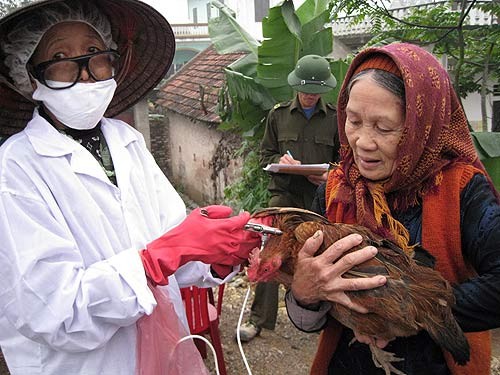
In Vietnam, villagers and authorities bent on halting the spread of avian influenza are now adept at stopping infected chickens from crossing the road. And they are gaining ground on the bigger challenge of keeping hens and ducks from crossing the country's borders to prevent outbreaks which threaten vast flocks of poultry and human health.
Raising his voice over the din of quacking ducks streaming into the river and a rooster objecting loudly as large trucks roared past, Nguyen Duc Hoa explained that he is once again able to support his family of six as a poultry farmer.
Like so many other farmers, Hoa's flock in Le Mon village, in central Quang Tri province, was devastated by an outbreak of H5N1 avian influenza in 2005. And like so many others, after a committed response by the Government of Vietnam, he got his backyard business back on track. It's a sign of the times, and of Vietnam's resilience and determination in the wake of disease.
With over $50 million in support over the past eight years, USAID has played a substantial role in supporting Vietnam's efforts to help farmers like Hoa fight off bird flu and to be even more efficient in handling the risks of future pandemics. In fact, most new viral strains of avian influenza over the past two years were identified directly through USAID support for laboratories and a national network of animal health workers and veterinarians at all levels who are now better equipped to track down viruses and handle outbreaks effectively.
Vietnam's success in coping with bird flu involves high stakes. Since 2003, Vietnamese authorities have had to cull over 63 million poultry in 40 of the country's 63 provinces. Of the 123 human cases of the H5N1 virus in Vietnam, 61 - almost 50 percent - were fatal. According to the World Health Organization, in September 2012, there were 608 human cases and 359 deaths from the disease in 15 countries around the globe.
According to Dr. To Long Thanh, director of the National Center for Veterinary Diagnostics (NCVD), which monitors and identifies virus strains, Vietnam's traditional way of raising poultry brings a special set of challenges for farmers in the north and the south of the country. "In our mixed system of husbandry in the countryside, a single household can raise chickens, ducks and muscovy ducks (large tropical, crested birds), so the transmission between species occurs naturally," he said, noting that 80 percent of all livestock in Vietnam is raised in backyard farms.
Most recent data from October 2011 indicate that Vietnam has 75 million ducks and over 232 million chickens. Millions more chickens are illegally imported into Vietnam from China each year, and the government has recently announced a crackdown on smuggled chickens to counter new concerns of H5N1 infections and mutated virus strains.
Since 2010, the NCVD and eight regional laboratories with equipment and training from USAID through the United Nations' Food and Agricultural Organization (FAO) have analyzed and identified 397 viruses from samples, including 217 in 2012 through September.
"If you look at the number of outbreaks, from 2003 until now, you can see the decrease in outbreaks year by year. Right now we can see that there is an epidemic, but it is sporadic," said Dr. Thanh.
In 2004, Vietnam recorded 2,574 H5N1 outbreaks. In 2011, that number dropped to 45. "Vietnam has a lot of success in controlling the disease," he added, pointing to such measures as vaccination, quarantine and disinfection as central to their approach.
According to NCVD Deputy Director Nguyen Tung, with USAID-sponsored equipment and training at all nine regional and national labs, test results that may previously have taken three days are now available within 24 hours.
With equipment to analyze viruses collected during USAID-supported surveillance activities such as at live birds markets, Vietnam is more efficient in controlling the spread of disease and reporting outbreaks.
"To control the disease, we have to know how the virus is introduced into the country," said FAO virologist Ken Inui. "If we know exactly how the virus is moving, the best way to control the virus is to cut this route."
The knowledge that Vietnamese and international experts have gained over the past decade in combatting highly pathogenic avian influenza also applies to other diseases.
"The experience we have gained in the control and prevention of avian influenza and also the technology we use for diagnosis for AI can also be used for other diseases, such as foot and mouth disease, blue ear disease affecting pigs, cholera, and classical swine fever," said Tung. "We can use the same molecular diagnosis machines, especially for viral diseases." He noted that the labs have been using the new equipment for blue ear disease, swine fever and Newcastle disease since 2007.
Knowing where to go when pandemics threaten to cross the road is farmer Hoa's first line of defense.







Comment
Make a general inquiry or suggest an improvement.